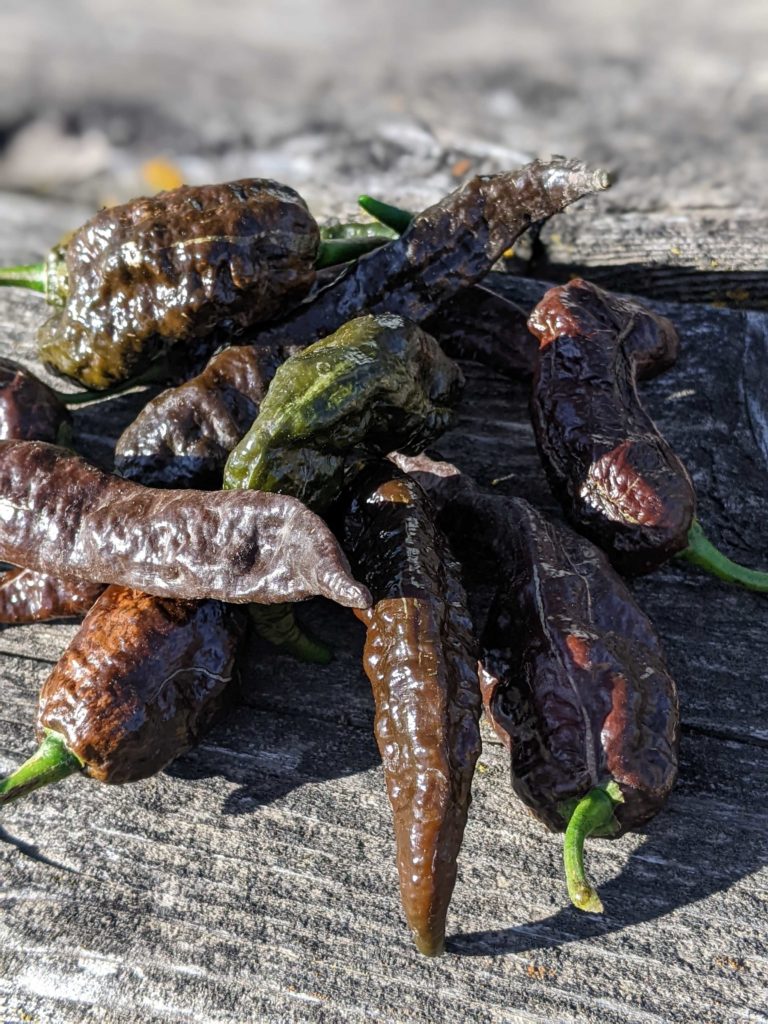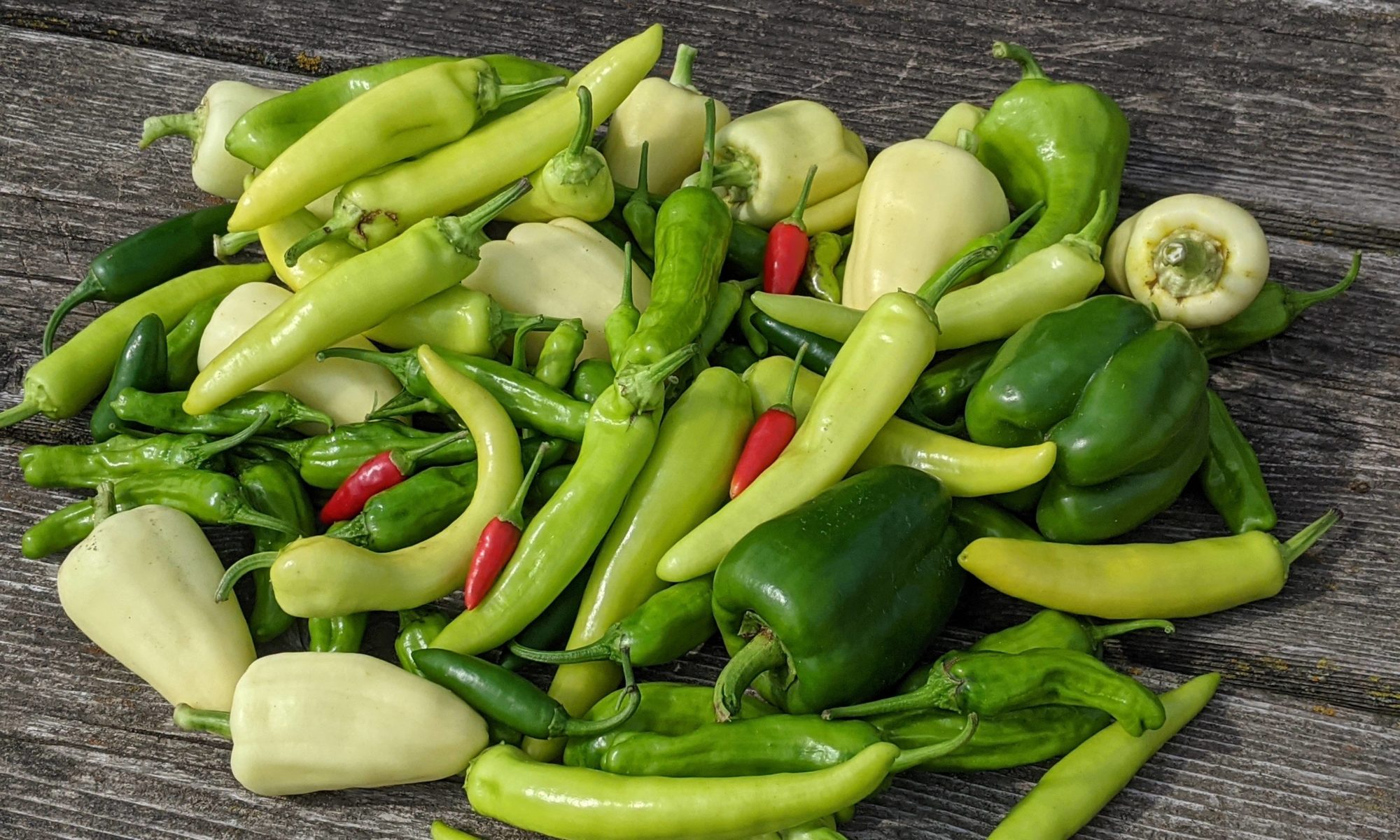
I’m obsessed with peppers. Perhaps it’s because I spent my formative years in the southern California desert. Perhaps it’s because I grew up in southern California AND my favorite band was the Red Hot Chili Peppers (sorry, not sorry). Perhaps I have a lot of supertaster buds. Perhaps it was the tour of the Louisiana Tabasco Factory at an early age (imagine those cute little jars going by one by one)…
Whatever the reason for this peculiar passion, it has nothing to do with an urge to engage in capsaicin contests (capsaicin is the chemical compound in peppers that makes them HOT). What I really like about peppers goes much deeper than seeing how many Scoville units I can ingest. For one thing, peppers have a fascinating transformation story, developing from a wild South American plant eaten by birds into thousands of varieties that are now the backbone of cuisines around the world. Each one with a unique personality, and they all add spice to our meals in countless ways whether it’s salsa, pickles, chili, curry, and more.
From Bird Food to World Food: The Fascinating History of Peppers
Peppers began as small berries in Peru eaten by birds, who cannot taste hot stuff. Since the Columbian exchange wherein the Old World colonized the New World, peppers have spread worldwide to serve as cornerstones of major cuisines across Asia, Africa, and Europe. This happened to the extent that world cuisines prior to 1500 would be unrecognizable to us today. What would going to a “Thai” or “Italian” restaurant in 1490 have looked like without peppers (or tomatoes or any number of other New World crops)?

As they spread across the world, peppers transformed into the numerous varieties we know today. The most widespread pepper species is Capsicum annum, which includes the bell pepper and most other peppers found at the grocery store. However, there are actually five distinct cultivated species (plus many other wild species). Capsicum chinense, which includes the habanero, is one of these, and it has some of the hottest peppers in the world. The other three species are even less common and aren’t typically found in grocery stores: Capsicum frutescens, Capsicum baccatum, and Capsicum pubescens. Capsicum frutescens peppers, of which the famed Tabasco pepper is a member, tend to be smaller, resembling the original wild varieties. The ají (C. baccatum) and rocoto (C. pubescens) species are common to cuisines of Peru, Bolivia, and surrounding regions. The book Peppers of the Americas is an amazing resource for those interested in learning more.
Thousands of Unique Varieties
This brings me to the second thing I love about peppers, which is their diversity. Some are sweet, some hot, some big, some not. Although many peppers can be used interchangeably, there are important distinctions in heat and size. Scoville units measure the capsaicin content in peppers. The higher the Scoville rating, the hotter the pepper.
From Sweet…


Sweet peppers have had the capsaicin bred out of them. Some are good for fresh eating (bell peppers), others for roasting (various red peppers, poblanos) or blistering (shishitos), and others as part of the base of a meal (banana, paprika peppers).

…To Hot…
Among hot peppers, the heat can quickly get out of hand. Milder hot peppers with low Scoville ratings, like hot wax and jalapeno peppers, add moderate heat and flavor to recipes.


As the Scoville units increase, we get red hots like cayenne, Thai, and many varieties that are popular across Asia.



…To Very Hot!
Even hotter peppers often have a heat that kicks in gradually or cumulatively, like habanero. Hotter than this and you get peppers with names like death reaper, Trinidad scorpion…you get the picture. These tend to be common in African and Caribbean cuisines.



An important thing to consider is that the heat or capsaicin is highest in the seeds and inside membranes of the pepper (except for sweet peppers, which have none). So the heat levels of your dish will depend on the extent to which you remove the seeds and insides of the peppers.
How to Use Them
Admittedly, I put hot stuff on everything. But even if you are not a pepper person, you likely already experience them in ways you didn’t realize. Or, perhaps you could add more of them to your diet not just for flavor but for nutrition: Peppers, especially red ones, are high in Vitamin C and B6. Moreover, some studies have shown their ability to reduce the risk of heart disease and cancer. They are also one of the easiest plants to grow, perhaps because their hot capsaicinoids defend them against fungal pathogens. Another fun fact: The leaves are edible too, although bitter.

Peppers form the base of many dishes around the world, whether as part of sofrito, paste, stew, or sauce. They also play a key role in many condiments, like salsa and hot sauce, and toppings, like dried spices and pickled peppers. Below are some of my favorite ways to use (and preserve) peppers, both sweet and hot.
Dry Them
The simplest thing to do with peppers is to dry them whole and store them in your cupboard. Add whole dried peppers to soups, stews, or beans for flavor, or grind them into powder to add as a seasoning alone or in combination with other spices. Make your own chili powder!


You can also rehydrate the whole peppers in hot water and blend them into a sauce (think paprika for paprikash or poblano for mole sauce).
My other favorite use of dried peppers is hot salt. It’s perfect for situations where you want heat but not in the form of hot sauce (also see: pepper jelly). What do you do? You add hot salt.

| Hot Salt Recipe |
| Ingredients: 1.5 cups sea salt 3 hot peppers, such as habanero (more or less, depending on your hotness preferences) |
| Directions: First: Make sure you’re wearing gloves. Hot peppers leave an oil on your fingers that will burn them and anything you touch (such as your eyeball…. ask me sometime about my extensive experience making this mistake). Combine the chopped, seeded peppers with the salt in a food processor and pulse until finely ground. Spread that on a sheet pan in the oven on the lowest heat setting (mine is 175) for about an hour, checking every 20 mins to stir the salt around. Once the mixture is dried or almost dry you can turn off the heat and leave in the oven overnight to cool. Pulse everything again the food processor to a fine texture (or leave clumpy if you prefer). Add herbs, citrus zest, pepper, or whatever else comes to mind to your hot salt. You can also blend the mash left over from making hot sauce (see below) with salt. Waste not, want not! |
Sauce ‘Em
Peppers are, of course, a key ingredient in various sauces from salsa to hot sauce and beyond. The great thing about salsa and hot sauce is that 1) you can easily make your own and 2) once you have the basic technique down, you can combine different peppers and other ingredients to make a hot sauce or salsa that suits your preferences.

Fire Salsa Verde from Tart and Sweet is one of my go-to salsa recipes. I like it because, unlike a lot of salsa recipes, it is made entirely with peppers whereas most other salsa recipes include tomatoes or tomatillos.



Pickle ‘Em
Who doesn’t enjoy a pickled pepper? Pickled peppers can range from sweet (roasted red peppers) to hot (pickled hot banana rings).

Sweeten Them
Hot pepper jelly has become my secret weapon. Imagine a spicy honey. Add it to sandwiches or bagels or combine with cheese or charcuterie, crackers, and herbs for a real smorgasbord. Oh lord, I’m fancy and I will not apologize. Once you include pepper jelly in your life, you will be fancy too. Check out these 8 Ways to Use Pepper Jelly for more ideas.

Roast Them
Roasted sweet red peppers probably deserve an entire article on their own because of how versatile (and delicious) they are. They can be served as an appetizer, blended into soup, added to hummus or pizza sauce, combined with walnuts or eggplant in a dip, or made into any number of piquant condiments like red pepper paste, ketchup … the list goes on. And, of course, they can be stuffed with all sorts of goodies and roasted for a complete meal.

Beyond Food
Peppers are not just a culinary catalyst. The same chemical compound that gives them their spice, capsaicin, is also a pain-relieving topical analgesic. They are used in organic herbicide sprays and are the subject of numerous research studies. The New Mexico Chile Pepper Institute is a leading center for pepper research. Peppers are even being grown on the International Space Station! As one of the investigators of this project stated, “Growing colorful vegetables in space can have long-term benefits for physical and psychological health . . . growing plants and vegetables with colors and smells helps to improve astronauts’ well-being.” I would argue that peppers improve non-astronauts’ well-being too, which is the final and probably ultimate reason for why I love these prolific, colorful plants so much.
Wisconsin, where I’ve lived for nearly 20 years now, isn’t exactly pepper land. Nonetheless, I strive. In 2021, I started a Pepper CSA. I’m trying my best to spread the pepper gospel across the land of the mild, potato-loving Midwest, one pepper at a time!



I want you to host a pepper party! 🌶 🫑
I want this too!